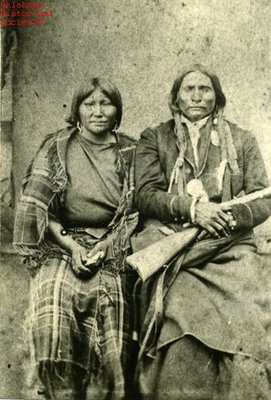Big Bow (Kiowa leader) facts for kids
Quick facts for kids
Big Bow
|
|
|---|---|
| Zepko-ette | |

Big Bow (right), Kiowa war chief
|
|
| Born | 1833 |
| Died | circa 1900 |
| Nationality | Kiowa |
Big Bow (born 1833, died around 1900) was an important Kiowa leader in the 1800s. He was a close friend and partner of other famous Kiowa leaders like Guipago and Satanta.
His name in the Kiowa language was Zepko-ette, which was also spelled Za-ko-yea. Big Bow was born in 1833 near Elk Creek, in an area that is now part of Oklahoma.
Contents
Big Bow's Early Actions
Big Bow was active in the southern plains. This area includes parts of what are now Kansas, Oklahoma, and Texas. He took part in actions against both Native and non-Native settlements.
The Warren Wagon Train Event
Big Bow was involved in the Warren Wagon Train Raid. This event happened on May 18, 1871, in Texas. Other Kiowa leaders like Satank, Satanta, Mamanti, White Horse, and Big Tree were also there.
Later, Satanta was talking to an Indian Agent. He mentioned that he had led the group at the Warren Wagon Train event. He also said that Satank and Big Tree were with him. Because he did not name the others, Big Bow and the other leaders were not taken into custody at that time.
The Howard Wells Station Attack
On April 20, 1872, Big Bow and White Horse led about one hundred Kiowa warriors. They also had allies from the Comanche tribe. They attacked a government wagon train at Howard Wells station. This station was along a trail between San Antonio and El Paso.
Soldiers from the 9th Cavalry tried to stop them. During the fight, some soldiers were injured. The soldiers had to retreat.
Later Years and Surrender
Big Bow joined forces with Guipago and the Comanche leader Quanah. He became well-known during the Comanche Campaign and the Red River War. He was one of the last Kiowa leaders to surrender to the United States. He surrendered in January 1875, following the advice of Tene-angopte. Guipago surrendered a bit later, on February 25, 1875.
Refusal to Sign Treaties
Big Bow strongly believed in fighting for his people's way of life. He did not want to sign the Treaty of Medicine Lodge in 1867. This treaty would have moved the Kiowa and Comanche people to a reservation in Oklahoma and Texas.
He also took part in the Battle of Adobe Walls. This was a fight to stop people from hunting buffalo on their tribal lands. Big Bow was determined to protect his lands and traditions. A Quaker missionary named Thomas Battey, who knew the tribe, even commented on Big Bow's fierce spirit.
When the Kiowas were moved to their reservation in 1875, Tene-angopte did not include Big Bow in the group of leaders sent to Fort Marion, Florida. Big Bow and his family settled near Rainy Mountain in Indian Territory.
See also
Images for kids


